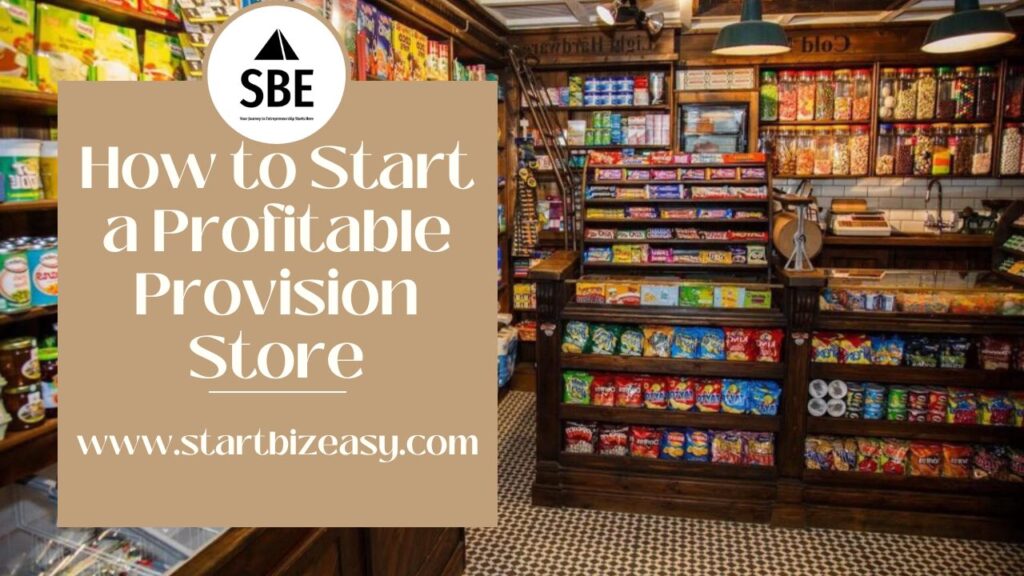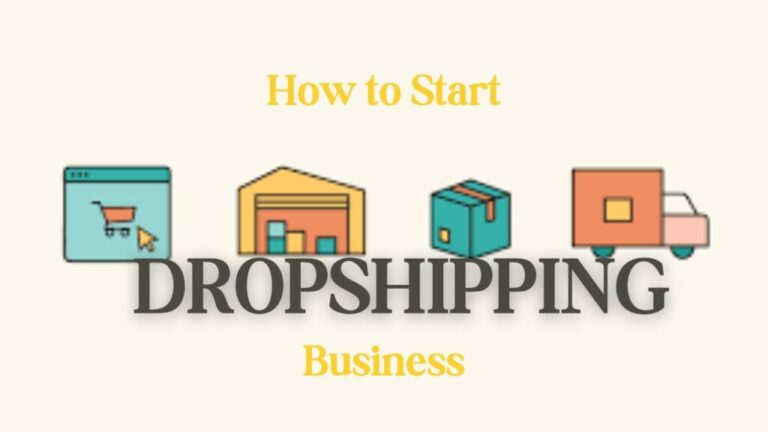
A provision store, often referred to as a grocery store or convenience store, is a retail establishment that primarily sells food items and other household essentials.
These stores typically offer a variety of products such as fresh produce, canned goods, dairy products, snacks, beverages, cleaning supplies, personal care items, and sometimes basic pharmaceuticals.
Provision stores are commonly found in residential neighborhoods and cater to the daily needs of local residents, providing convenient access to essential items without the need to travel to larger supermarkets.
In Nigeria, a thriving provision store can generate profits ranging from a few thousand to tens of thousands of naira per day, with monthly profits varying from tens of thousands to hundreds of thousands of naira. This makes it a profitable business to start.
Nevertheless, armed with the insights from this article, you’ll gain valuable knowledge on how to start and run a profitable provision store.
Here is how you can start a profitable provision store:
Table of Contents
1. Decide on Your Specialty:
When determining your niche for a provision store, you need to decide whether you will specialize in offering perishable items, non-perishable items, or both types of products.
Perishable items are goods that have a limited shelf life and require refrigeration or other preservation methods to maintain their freshness. These may include fruits, vegetables, dairy products, meat, fish, and bakery items. Non-perishable items, on the other hand, are goods that have a longer shelf life and do not require refrigeration. These may include canned goods, dry pantry staples like rice and pasta, beverages, snacks, and household essentials.
Understanding the needs and preferences of your target market is crucial in making this decision. For example, if your store is located in an area with a high demand for fresh produce and daily essentials, focusing on perishable items might be more profitable. Conversely, if your target market consists of busy working professionals who prioritize convenience and shelf-stable products, then emphasizing non-perishable items could be more beneficial.
Your choice may also be swayed by studying your competitors in your preferred business area. For example, if you observe that your competitors mainly deal in perishable goods while few or none offer non-perishable items, you can strategize effectively by entering the market with a focus on non-perishable items, or by offering both types of products if you have the capital to do so.
By tailoring your offerings to meet the specific needs of your target customers, you can effectively differentiate your provision store and attract loyal clientele. This strategic approach also enables you to optimize your inventory management, pricing strategy, and marketing efforts, ultimately leading to a more profitable business.
2. Secure Sufficient Capital:
The total capital needed to start a provision store business in Nigeria could range from ₦500,000 to ₦2,500,000 or more depending on several factors such as location, size of the store, inventory selection, and operating expenses.
This capital will be spent on several factors such as;
- Rent
- Fixtures and Equipment
- Utilities (water bill, electricity and so on)
- Inventory
- Licenses and Permits
- Marketing
- Miscellaneous Expenses
Keep in mind that in the early stage phase of launching a provision store business, your priority will be to recover the expenses incurred. This implies that it might take some time for your provision store to start making profits. Ensure that you have sufficient capital to support your business during this early period.
Maintaining a financial buffer will enable you to navigate unforeseen obstacles and enhance your business’s prospects for success.
If you’re struggling to raise the necessary capital for your business, you have the option to obtain funding from various sources. Such as:
- Personal Savings: Utilize your own savings accumulated over time to invest in your business venture. This can be a reliable and readily available source of capital without the need for external approval.
- Family and Friends: Seek financial support from family members or friends who believe in your business idea. They may be willing to provide loans or investments to help you get started.
- Bank Loans: Approach banks or financial institutions for business loans. Prepare a solid business plan and financial projections to demonstrate your ability to repay the loan. Consider both traditional banks and microfinance institutions that cater to small businesses.
- Government Grants and Programs: Explore government grants, subsidies, or programs aimed at supporting small and medium-sized enterprises (SMEs). These initiatives may offer financial assistance, training, or other forms of support to help you launch your provision store business.
- Crowdfunding: Consider crowdfunding platforms where individuals or groups contribute funds to support your business idea in exchange for rewards or equity. Platforms like Kickstarter, Indiegogo, or local crowdfunding platforms can help you raise capital from a wide audience.
- Trade Credit: Talk to your suppliers about getting good payment terms. This means you can get stock without paying straight away, which helps save your money at the start. However, they might ask for someone to guarantee the payment, especially since you’re new to the business and just starting to build a relationship with them.
- Partnerships: Explore partnerships with suppliers, distributors, or other businesses in the industry who may be willing to provide financial support or assistance in exchange for mutual benefits or collaborations.
Each option comes with its own advantages and considerations, so carefully evaluate which sources align best with your business goals and financial situation.
3. Select a Prime Location:
Some successful provision store owners might claim, “location isn’t everything. As long as you stock your store well, customers will come from afar to find you and make purchases.”
While there’s some truth to this, rather than waiting for customers to seek you out, why not invest your efforts and resources in securing a prime location? This way, it’ll be easier and more convenient for customers to find and access your store.
As a newcomer in the business, the location significantly influences the success of your provision store. Unlike established store owners who can draw customers from afar, new businesses benefit greatly from being in a high-traffic area. These established businesses can transform a previously overlooked location into a bustling market hub almost overnight.
Here is how you can spot a strategic location for your provision store:
- High Foot Traffic: Choose areas with high foot traffic, where many people pass by regularly. This increases the visibility of your store and exposes it to potential customers. Locations near busy streets, markets, or transportation hubs are ideal.
- Residential Neighborhoods: Setting up your store in residential neighborhoods ensures a steady flow of customers, as residents will frequently visit for their daily shopping needs. It’s convenient for them to access essential items close to home.
- Commercial Centers: If feasible, consider locating your store in commercial centers or business districts. Employees and workers from nearby offices often require quick access to provisions during lunch breaks or after work.
- Proximity to Markets: Being close to wholesale markets or suppliers can be advantageous for restocking inventory efficiently and possibly obtaining better deals on products. This proximity helps maintain a competitive edge in pricing and availability.
- Near Schools: Establishing your store near schools or educational institutions can attract student customers and their families. Providing snacks, beverages, and other essentials popular among students can boost sales.
- Accessibility: Ensure easy accessibility for customers, including ample parking space if applicable and convenient transportation options. A location with good visibility and signage also helps attract passing pedestrians and motorists.
- Residential Areas: Targeting residential areas ensures a consistent customer base, especially if there are limited provision store options nearby. Consider the demographics of the area to tailor your product selection to the preferences of local residents.
By carefully selecting a strategic location that aligns with these considerations, you can maximize the potential for your provision store’s success. It’s essential to conduct thorough market research and evaluate various factors such as competition, demographics, and local demand to make an informed decision about the best location for your business.
4. Set Up Your Shop:
Once you’ve identified and secured the ideal location, it’s essential to ensure that your shop is visually appealing and efficiently organized. This enables customers to easily find what they’re looking for and allows you to locate items quickly based on customer demand.
The main aim is to create a welcoming atmosphere that attracts customers and encourages them to explore your store. Consider factors like lighting, decor, and cleanliness to make a positive first impression.
To set up your store for maximum appeal and organization, you’ll need to have the following equipment and fittings in place:
- Sturdy Shelving: Invest in durable and functional shelves to display your products effectively. Arrange items logically and categorically to make it easy for customers to find what they need. Adjustable shelves allow flexibility in accommodating different product sizes.
- Refrigeration Units: If you plan to sell perishable items such as fruits, vegetables, dairy, fish, or meats, invest in reliable refrigeration units. Ensure they are properly maintained to preserve the freshness and quality of perishable goods.
- Display Racks: Use display racks or stands to showcase featured or promotional items prominently. This can attract customers’ attention and encourage impulse purchases. Consider rotating products regularly to keep displays fresh and interesting.
- Adequate Space: Ensure there is ample space for customers to move around comfortably and browse your offerings. Avoid overcrowding shelves or aisles, as this can create a cramped and unpleasant shopping experience.
- Checkout Area (only for medium and large-scale provision stores): Designate a clearly marked checkout area with a cash register or POS system for seamless transactions. Keep this area tidy and clutter-free to expedite the checkout process.
- Signage and Branding: Use clear signage and branding elements throughout your store to reinforce your brand identity and help customers navigate the space. This includes signage for product categories, pricing, promotions, and store policies.
- Safety and Accessibility: Prioritize safety by ensuring aisles are wide enough to accommodate wheelchairs and strollers, and that shelves are securely anchored to prevent accidents. Maintain cleanliness and organize storage areas to minimize hazards.
By paying attention to these details and creating an inviting and organized space, you can enhance the overall shopping experience for your customers and increase the likelihood of repeat visits and positive word-of-mouth recommendations. Additionally, a well-designed store layout can contribute to increased sales and customer satisfaction.
5. Fulfill Legal Requirements:
As a potential provision store owner, you must be aware that before you can operate your business, you have to fulfill some basic legal requirements, which is crucial to avoid potential penalties, fines, or legal consequences that could impact the success of your provision store business.
In Nigeria, the legal requirement is not really a hurdle as it requires just two basic legal requirements;
In addition to those two, you have to comply with health and safety regulations to ensure the well-being of your customers and employees. This include not being a promoter of inferior items, maintaining cleanliness and hygiene standards, and implementing proper sanitation practices.
Depending on the nature of your provision store business, you may need additional permits or licenses for specialized operations. For example, if you plan to sell alcoholic beverages, you may need a separate liquor license.
Fulfilling these legal requirements not only prevents fines and penalty, It also helps build trust and credibility with customers, suppliers, and regulatory authorities. Be sure to research and understand the specific legal requirements applicable to your business and take the necessary steps to ensure compliance before opening your provision store.
6. Stock Your Provision Store:
Stocking involves carefully selecting and purchasing the products that you’ll offer for sale in your provision store. This could include both perishable and non-perishable items such as groceries, household essentials, snacks, beverages, and other everyday necessities depending on the specialty you have choose your provision business to be known for.
When stocking your store, consider factors such as:
- Product Selection: Choose a diverse range of products to meet the needs and preferences of your target market. Consider local dietary habits, cultural preferences, and popular brands to ensure a well-rounded inventory.
- Quality: Prioritize quality when selecting products to stock. Source items from reputable suppliers known for freshness, reliability, and consistent quality. High-quality products contribute to customer satisfaction and loyalty.
- Quantity: Determine the appropriate quantities of each product based on anticipated demand, shelf life, and storage capacity. Avoid overstocking items that have a limited shelf life to minimize waste and spoilage.
- Variety: Offer a variety of options within each product category to cater to different tastes and preferences. Provide options for various dietary restrictions, lifestyles, and budgets to appeal to a broad customer base.
- Seasonal Considerations: Consider seasonal fluctuations in demand when stocking your store. Adjust your inventory to reflect seasonal trends and holidays, such as stocking up on holiday-themed products or seasonal produce.
- Display and Organization: Arrange products logically and attractively to make it easy for customers to find what they need. Use clear signage, attractive displays, and organized shelves to enhance the shopping experience.
Stocking your provision store effectively requires careful planning, attention to detail, and an understanding of your target market’s needs and preferences. By curating a well-balanced inventory of high-quality products, you can attract customers, drive sales, and build a successful provision store business.
There are various options for purchasing stock for your provision store:
- Wholesale Markets: Wholesale markets are a common source for purchasing stock in bulk at competitive prices. Popular wholesale markets in Nigeria include:
- Lagos: Lagos International Trade Fair Complex, Alaba International Market, Mile 12 Market.
- Kano: Sabon Gari Market, Kantin Kwari Market.
- Onitsha: Onitsha Main Market, Relief Market.
- Distributors and Suppliers: Connect with distributors and suppliers who specialize in providing goods to retail businesses like provision stores. These suppliers often offer a wide range of products and may provide delivery services for convenience.
- Manufacturers: Some provision store owners choose to purchase directly from manufacturers, especially for branded or specialty products. Contact manufacturers of specific products to inquire about purchasing options and wholesale pricing.
- Online Marketplaces: Explore online marketplaces and e-commerce platforms that cater to wholesale buyers. Websites like Jumia, Konga, and Alibaba may offer a range of products suitable for provision stores, with the convenience of online ordering and delivery.
- Trade Associations and Cooperatives: Join trade associations or cooperatives that provide access to bulk purchasing opportunities and negotiated deals with suppliers. These organizations may offer discounts and other benefits to members.
- Local Suppliers and Farmers: Consider sourcing fresh produce and locally-made goods directly from farmers, cooperatives, or local suppliers. This supports local producers and ensures the freshness and quality of products.
- Trade Shows and Exhibitions: Attend trade shows, exhibitions, and industry events where wholesalers, distributors, and manufacturers showcase their products. These events provide opportunities to network, discover new products, and negotiate deals.
When purchasing stock for your provision store, consider factors such as product quality, pricing, reliability of suppliers, and proximity to your store location. It’s also essential to maintain good relationships with suppliers to ensure consistent supply and favorable terms.
You should also be mindful of common mistakes made by provision store owners that you must avoid at all costs, or else you might incur unnecessary losses and experience a slow business growth.
- Overstocking: Buying too much inventory without considering demand fluctuations can lead to wastage, expired products, and tied-up capital. It’s crucial to strike a balance and maintain optimal inventory levels based on sales patterns and shelf life.
- Understocking: Conversely, underestimating demand and failing to stock enough inventory can result in stockouts, dissatisfied customers, and missed sales opportunities. Regularly monitor inventory levels and replenish stock promptly to meet customer needs.
- Poor Product Selection: Stocking products that don’t resonate with your target market’s preferences or buying products solely based on personal preferences without considering customer demand can lead to slow-moving inventory and reduced profitability. Conduct market research and analyze customer preferences to curate a relevant product assortment.
- Ignoring Seasonal Trends: Neglecting to adjust inventory based on seasonal demand fluctuations can result in missed sales opportunities and excess inventory during off-peak seasons. Pay attention to seasonal trends and adjust your stock accordingly to capitalize on seasonal demand peaks.
- Lack of Variety: Failing to offer a diverse range of products within each category can limit customer choice and satisfaction. Ensure your store offers variety in terms of brands, sizes, and price points to cater to different preferences and budgets.
- Poor Quality Control: Neglecting to check product quality or failing to rotate stock regularly can lead to selling expired or damaged goods, damaging your store’s reputation and customer trust. Implement strict quality control measures and regularly inspect inventory to ensure freshness and quality.
- Failure to Negotiate with Suppliers: Accepting prices at face value without negotiating with suppliers can lead to higher costs and reduced profit margins. Build strong relationships with suppliers and negotiate favorable terms, including pricing, discounts, and payment terms, to maximize profitability.
- Inefficient Inventory Management: Relying on manual inventory management processes or failing to utilize technology to track inventory accurately can result in inventory discrepancies, stockouts, and overstocking. Invest in inventory management software and implement efficient systems to track stock levels, sales data, and reorder points effectively.
- Ignoring Customer Feedback: Disregarding customer feedback and failing to adapt inventory based on customer preferences can lead to missed opportunities for improvement and reduced customer satisfaction. Solicit feedback from customers regularly and use this information to refine your product selection and offerings.
- Not Monitoring Market Trends: Failing to stay informed about market trends, industry developments, and competitor strategies can result in being left behind or losing out on emerging opportunities. Stay abreast of market trends, consumer preferences, and competitor activities to make informed decisions about stocking your provision store.
- Copy and Paste: This mistake is quite prevalent among provision store owners. Instead of aiming to stand out by offering a diverse range of products, they often mimic their competitors’ inventory. This oversight contributes to the challenges faced by many new provision store owners in establishing themselves in the market and securing a significant market share. Consequently, some end up relocating their businesses to different locations, wrongly attributing their struggles to their initial choice of location rather than recognizing that their lack of unique stocking strategies hindered their success from the start, even before they started facing the intense competition.
Here is a list of common items needed in a provision shop to guide your stocking process:
- Food Items:
- Rice
- Pasta
- Flour
- Beans
- Lentils
- Canned vegetables and fruits
- Cooking oil
- Spices and seasonings
- Sauces and condiments
- Beverages:
- Bottled water
- Soft drinks (sodas)
- Fruit juices
- Tea and coffee
- Energy drinks
- Dairy Products:
- Milk (fresh and UHT)
- Cheese
- Butter
- Yogurt
- Eggs
- Snacks and Confectionery:
- Chips and crisps
- Biscuits and cookies
- Chocolate bars
- Candy and sweets
- Nuts and seeds
- Fresh Produce:
- Fruits (e.g., apples, bananas, oranges)
- Vegetables (e.g., tomatoes, onions, potatoes, carrots)
- Herbs and greens
- Bakery Items:
- Bread (sliced and unsliced)
- Pastries
- Cakes and muffins
- Frozen Foods:
- Frozen vegetables
- Frozen fruits
- Frozen meats and seafood
- Ice cream and frozen desserts
- Household Essentials:
- Toilet paper
- Cleaning products (e.g., detergents, disinfectants)
- Personal hygiene products (e.g., soap, shampoo, toothpaste)
- Paper towels
- Batteries
- Canned Goods:
- Canned soups
- Canned beans
- Canned fish and meats
- Canned fruits
- Health and Wellness:
- Over-the-counter medications (e.g., pain relievers, cold medicine)
- First aid supplies (e.g., bandages, antiseptics)
- Vitamins and supplements
- Baby Care Products:
- Diapers
- Baby wipes
- Baby food and formula
- Pet Supplies (if there is demand for it in your location):
- Pet food
- Pet treats
- Pet accessories
These are just some of the items commonly found in a provision shop. The specific range of products may vary depending on the size of the store, its location, and the preferences of the customers it serves.
7. Build a Strong Brand:
Building a strong brand for your provision store is essential for establishing a distinct identity and becoming the preferred destination for customers in your chosen location. This process involves several key steps aimed at creating a memorable and trustworthy image for your business.
Firstly, investing in signage and logo design is crucial. Your store’s signage should be visually appealing and easy to spot, while your logo should reflect the essence of your brand and stick in customers’ minds.
Beyond physical branding, developing a unique identity is essential. This encompasses your store’s name, tagline, color scheme, and overall aesthetic. This cohesive identity helps to differentiate your store from competitors and leaves a lasting impression on customers.
Marketing materials play a vital role in promoting your brand. Well-designed flyers, brochures, and business cards can effectively communicate your store’s offerings and values to potential customers, further solidifying your brand identity. -You might consider avoiding these expenses if you are not going to be operating a medium or Large-scale provision store.
Offering competitive pricing and high-quality products is another key aspect of building your brand. Customers are drawn to stores that provide value for their money, so striking the right balance between affordability and quality is crucial.
Equally important is prioritizing customer service. Training your staff to be friendly, helpful, and knowledgeable creates positive interactions that enhance the overall shopping experience. Positive experiences lead to customer loyalty and word-of-mouth recommendations, further strengthening your brand.
By following these steps and consistently delivering on your brand promise, your provision store can become the go-to destination in your community. Building a strong brand fosters trust and loyalty among customers, paving the way for long-term success and growth.
Is having a Business Plan necessary when starting a Provision Store?
Yes, having a business plan is essential when starting a provision store. A business plan serves as a roadmap for your business, outlining your goals, strategies, and the steps you’ll take to achieve success. Here’s why a business plan is necessary:
- Clarifies Your Vision: A business plan helps you clarify your vision for the provision store and articulate your goals and objectives. It allows you to define your target market, identify your unique selling proposition, and outline your plans for growth.
- Provides Direction: By laying out your strategies and action plans, a business plan provides direction for your provision store business. It helps you stay focused on your goals and guides decision-making as you navigate the challenges of starting and running a business.
- Attracts Investors and Lenders: If you need financing to start your provision store, a well-written business plan can help attract investors and lenders. It demonstrates your understanding of the market, your business model, and your plans for profitability, increasing confidence in the viability of your venture.
- Aids in Budgeting and Financial Planning: A business plan includes financial projections, such as startup costs, operating expenses, and revenue forecasts. This helps you estimate the capital required to start and sustain your provision store and plan your finances accordingly.
- Identifies Potential Challenges and Risks: Through market research and analysis, a business plan helps identify potential challenges and risks that may affect your provision store business. By anticipating these challenges, you can develop strategies to mitigate risks and overcome obstacles.
- Promotes Accountability: A business plan serves as a tool for accountability, both to yourself and to stakeholders such as investors or partners. It provides a framework for measuring progress against your goals and allows you to track performance over time.
Overall, a business plan is a valuable tool for planning, launching, and growing your provision store business. Whether you’re starting a small neighborhood shop or planning to expand into a chain of stores, having a solid business plan can significantly increase your chances of success. To create that perfect business plan, you can read our curated resources on writing a business plan
Challenges of Provision Store Business
Running a provision store may seem simple, but it comes with numerous challenges typical of the retail sector. Competition is fierce, with provision stores competing mainly against supermarkets and other provision store retailers for market share. Profitability is tricky to maintain due to consumer price sensitivity and the need to stay competitive.
Managing inventory is crucial yet complex, balancing customer demand with avoiding overstocking or running out of stock. Adapting to changing consumer preferences, seasonal fluctuations, and regulatory requirements adds to the challenge. Technology integration presents both opportunities and hurdles, as stores try to embrace e-commerce while preserving their traditional setup.
Customer retention is vital, requiring exceptional service and understanding of customer needs. Supply chain disruptions, such as supplier shortages or transportation delays, further complicate matters, necessitating robust contingency plans.
To succeed, provision store owners must be adaptable, innovative, and dedicated to customer satisfaction. Strategic planning, effective management, and a commitment to excellence are key to thriving in this competitive retail landscape.
Discover more from StartBizEasy
Subscribe to get the latest posts to your email.





